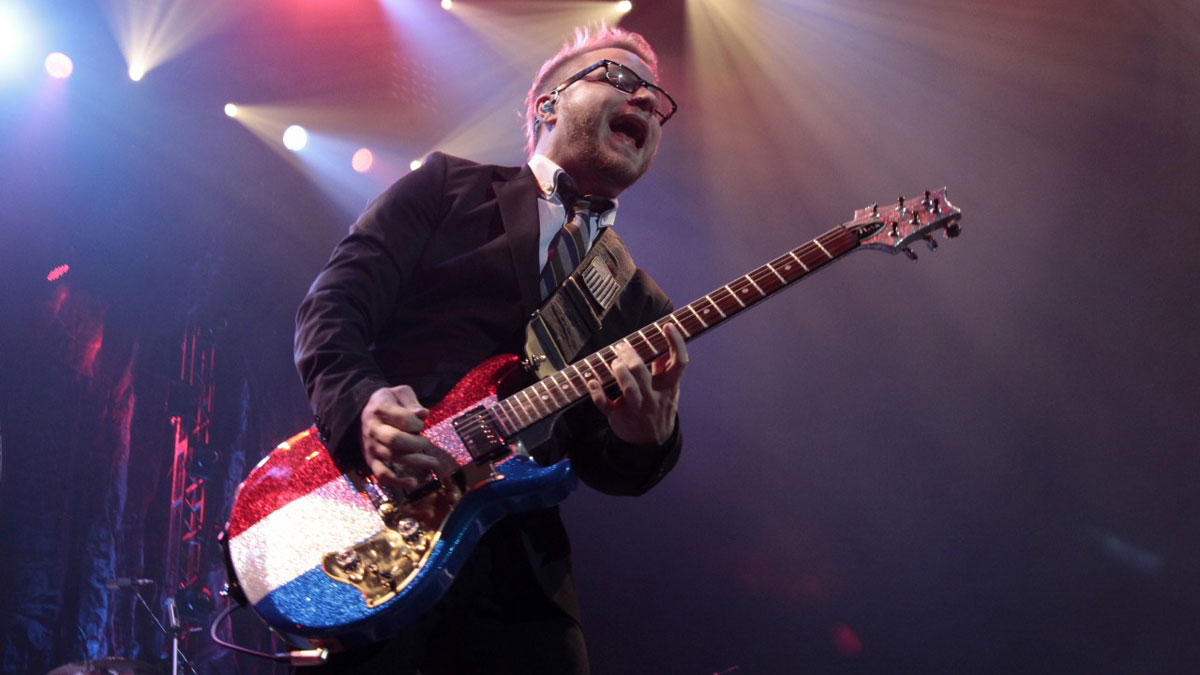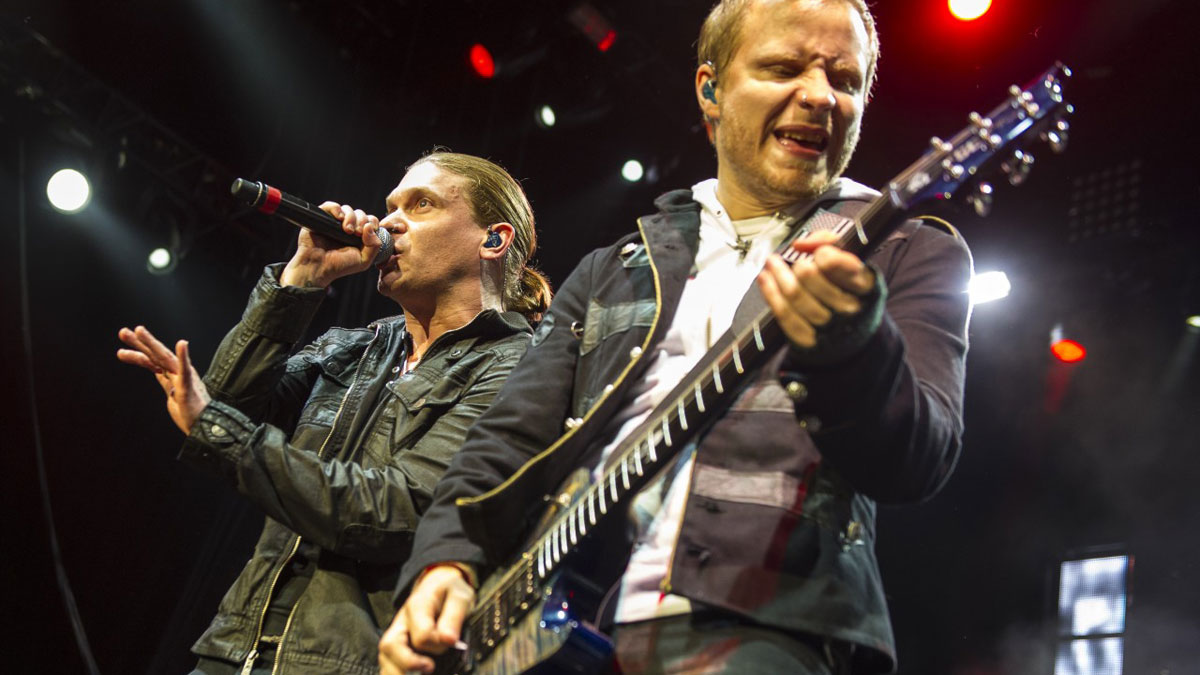Zach Myers on Shinedown, semi-hollows and playing solo
Thinking big with the Shinedown six-stringer

Introduction
Shinedowns’s PRS-toting tonesmith, Zach Myers, talks about getting huge sounds from small amps and why his band aren’t afraid of change in their pursuit of greatness...
Ambition is not a dirty word in Shinedown’s world. In fact, it barely does justice to the US band’s insatiable drive.
Nothing will ever be good enough. You can look at that in a negative light or a positive light like we do
“I’ve heard bands say, ‘We won’t be happy until…’ so many times,” the band’s lone guitarist Zach Myers tells us. “Well the difference between them and us is that we’re happy but we’ll never be content. Nothing will ever be good enough. You can look at that in a negative light or a positive light like we do. We’ll never be satisfied, because there’s no ceiling, there’s no mountain top.”
Zach isn’t being a hype man here, because Shinedown’s continued ascent is walking his talk in the US and in Europe. Frontman Brent Smith’s belief in big has infected his band – now a stable line-up after the changing members of the early days – seeing Shinedown shifting serious units and playing arenas, when most of those other rock bands Zach is talking about… well they’re not even close.
Shinedown’s unashamedly huge radio-rock songs are connecting, and that’s all the more interesting because stylistically they seem to be continuously on the move from the Southern roots of their early days. Which has brought Zach and the band to the bombastic rhythms, bold messages and immediacy of fifth album, Threat To Survival.
Shinedown was previously a two-guitar band, but since 2012’s Amaryllis, Zach, a member of the line-up since 2005, has been flying solo. But that hasn’t stopped the Memphis-born guitarist moving outside his comfort zones with tone and instruments, however…
Win a limited-edition Carnival Of Madness PRS electric guitar from Black Stone Cherry and Shinedown

Threat To Survival
Threat To Survival has more of an organic band sound than your previous albums…
“Absolutely, it’s definitely a record that for us, the writing came a lot more naturally and it was something that we really enjoyed. It was the most non-stressed record we’ve ever done, to the point where it was just easy to come by the songs.
I call this record ‘weight heavy’, there’s so much weight in it. So it’s heavy like that but we didn’t go into it like that
“There was no struggle and it felt really natural, there was no stress or time limit. Let’s just go in and make a record and what came out was what came out. It was very loose and way less polished than The Sound Of Madness and Amaryllis.”
Rhythmically, this is a very up-front, heavy album, was that a conscious decision?
“We knew that the songs had very heavy subject matter and like you said, it’s a heavy record, but I’ve said that to other journalists and had them go, ‘Heavy like how? Heavy like Machine Head?’
“And it’s not that, I tell people all the time; Tool is one of the heaviest bands I’ve ever seen. They don’t have any fast songs. I call this record ‘weight heavy’, there’s so much weight in it. So it’s heavy like that but we didn’t go into it like that. Because we don’t go into it saying we’re going to make a type A or B record.
“Guitar-wise it was so much fun to do this record because it wasn’t, ‘Let’s take eight Marshall tracks, eight Diesel tracks, a couple of combo tracks. It was a case of ‘Let’s take an eight-inch Rickenbacker combo and put four mics on it, and a Superfuzz, and make this little combo make the biggest noise we can.’ That’s what made it so heavy I think.”

Uncomfortable gear
So you were quite experimental with gear in the studio?
“Oh yes, we took ourselves completely out of our comfort zones on this record. I play PRS live and I play a lot of PRSs in the studio normally, but I brought my ’68 ES-335 to the studio, which was used for probably 80 per cent of the record.
We took a Jack White/Billy Gibbons approach to guitars, where less is more
“Two of my PRSs were also used; my signature model and a studio model that Paul [Reed Smith] made me, and then some Teles and Strats. We tried to find the best thing for the song and stuff we’re not used to.
“Especially with amps, there might be three heads on this record. It’s mostly little combos and things that are so different. We took a Jack White/Billy Gibbons approach to guitars, where less is more. We don’t need stacks of guitars, let’s just use one or two. Make them sound as full and big as possible.”
What other amps were used?
“There was one called a Stinger, I played one for the first time when I was 15 years old at the NAMM show. I remember the guy from [the band] Alabama played them. We recorded most of the guitars at a place called The Lair in Los Angeles.
“This guy Larry [there] had more amps than you’ve ever seen. We had an Ampeg Jet, another Ampeg [Reverberocket], that old 40s Rickenbacker with an eight-inch speaker was one of the main ones.
“Our tech on the record, Hans Buscher, he’s been Billy Joe from Green Day’s tech for 10 years, and he made a head that was almost like a JTM45. I used that and an old Orange head. That was mostly it… with a couple of old Fender Tweeds too.”

Semi-hollow sounds
What’s drawn you to use semi-hollow guitars more and more?
“It’s something that I’ve gravitated to, and I haven’t even thought about until now. I love them. Even on the record there’s a 335, and my new signature is semi-hollow.
I play piano on Thick As Thieves and that’s one of my favourite songs
“I was also using a lot of the Singlecut Hollowbody II’s on the last tour and I still use five of them on this tour. I like the fact that they’re light but they just push a bit more air I think.”
It also sounds like other instruments are driving some of these songs rather than guitar riffs…
“I play piano on Thick As Thieves and that’s one of my favourite songs. That to me was way more piano-driven than guitar-driven. The guitars became more of an Edge thing, there’s a jangly 12-string-type part in the beginning, but that song was about the piano. And Black Cadillac, you’d think that was more driven by piano, but it was the riff.”

Playing solo
What about Oblivion?
“The demo for that is completely different, honestly the demo was this riff and it was kind of Clutch-ish, which is cool because we’re all big Clutch fans, but it wasn’t us. It was Eric’s [Bass, who fittingly plays bass] idea to take that riff out and [add] the backup singers on that. It was originally driven by the riff, and then the rhythm.”
You’re the sole guitarist in Shinedown; how have you had to approach that role in the way you think about parts?
What I was going for was, don’t try to outsmart what’s been going on for years in music
“The biggest misconception when a band goes from a two- to one-guitar band is that the guy who’s left thinks he has to do more. I don’t agree with that, you do less and let the rhythm take over the song more. And that’s kind of what I do now, I try to do less but fill up the space.
“This isn’t the best representation of less, but The Edge is one of my favourite guitar players and if you really think about Where The Streets Have No Name he’s playing two parts, but that sounds like a wall of guitars. And that’s kind of where I came from on The Sound Of Madness, Amaryllis and especially on this record.
“A song like Black Cadillac, that’s two guitars. It’s just one riff, kind of a Led Zeppelin When The Levee Breaks-type song. What I was going for was, don’t try to outsmart what’s been going on for years in music, from the dawn of old delta blues and even classical music. Don’t try to overthink.”

Dare to be different
Shinedown aren’t afraid to be ambitious, but what keeps driving you forward, musically?
“I just can’t make the same record over and over again. I get that bands do it, and say, ‘this is our sound, and we don’t want to stray too far from our sound’. Okay, write the same record five times, but we can’t do that.
I wish bands would be more daring, because this record sounds like nothing we’ve ever done
“There are people who save their money to buy a record and tickets to a show, and they buy tickets for not only them, but their wife and kids. In this day and age in this economy that’s not the easiest thing to do.
“So we’re not going to give you the same record, we’re going to give you something new and fresh because you deserve that as a fan. And we deserve to challenge ourselves as a band. It’s a mutual respect for the fans and ourselves.
“I wish bands would be more daring, because this record sounds like nothing we’ve ever done.”
Win a limited-edition Carnival Of Madness PRS electric guitar from Black Stone Cherry and Shinedown

Rob is the Reviews Editor for GuitarWorld.com and MusicRadar guitars, so spends most of his waking hours (and beyond) thinking about and trying the latest gear while making sure our reviews team is giving you thorough and honest tests of it. He's worked for guitar mags and sites as a writer and editor for nearly 20 years but still winces at the thought of restringing anything with a Floyd Rose.

